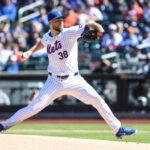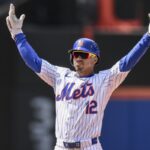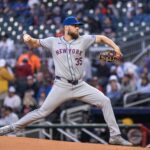
Gregory Fisher-USA TODAY Sports
Questions still linger about how the shift ban will affect the total number of hits in baseball—and if banning the shift really does anything at all. (If you look at year-over-year heat maps of where players position themselves, there’s not really a huge change from 2022 to 2023.) But whether the Mets are shading their infield toward second or playing straight up, they are hitting all the right notes in the field so far this season.
Each game produces at least one or two highlight-worthy plays. They also make tough plays seem routine. In Monday night’s Dodgers game, Francisco Lindor—a proponent of banning the shift—twice in the first couple of innings ranged to his left, played tricky hops off the dirt, and threw a runner out at first. Brandon Nimmo chased down yet another fly ball a day after two spectacular catches on 50-50 balls against the A’s. Brett Baty, in his first day back in the majors, threw out a speedy Miguel Vargas on a ball deep behind third base.
It’s happening every day. The advanced numbers back up the traditional, too.
Small sample size considered, the Mets are:
- Fifth in defensive runs saved (8)
- Seventh in Outs Above Average (3)
- First in ultimate zone rating (8.0), which tries to quantify how many runs a fielder has saved with their abilities
For more traditional stats, the Mets have just two errors—and they came on throwing errors from catchers. Their .997 fielding percentage is first in the majors.
The traditional stats tell you the team has made every play they’ve gotten to. The advanced numbers show they’re getting to more balls than the average team and executing.
Brandon Nimmo’s game-saving catch in the ninth inning had just a 35% catch probability.
He covered 70 feet in the 4.1 seconds the ball was in the air. pic.twitter.com/jBh5GkS1hm
— Patrick (@patrickrglynn) April 17, 2023
For example, Brandon Nimmo’s game-saving catch on Sunday had just a 35% chance of getting caught. If he didn’t make that catch and the ball bounced off his glove, neither traditional nor advanced metrics wouldn’t really ding Nimmo. However, he 1) got to the ball at the right angle and speed, which is often hard enough on its own, and 2) made the play. Nearly every Met has been doing that all year, resulting in solid advanced metrics that confirm the eye test. (Starling Marte is the only Met who’s missed balls in the outfield that have a greater than 50% chance of being caught.)
In the infield—Pete Alonso, Jeff McNeil, Lindor, and Eduardo Escobar—everyone has an average or above OAA number. (Escobar has a surprising three outs above average, which is in part due to his success rate landing 5% above his estimated success rate.)
Update: Shortly after publishing, Sports Info Solutions highlighted the Mets have converted 80.3% of their ground balls and bunts into outs so far, which is 8% higher than in 2022.
The offense is coming around, and the pitching has held strong after the injury bug ran through the team in the first couple weeks of the season. But the defense has been strong since Opening Day, nearly removing all mistakes and making plays an average fielder wouldn’t. It’ll be crucial to remain that way as the pitching staff heals.















